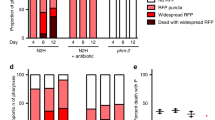Abstract
WE have found that mutations in the gene daf-2 can cause fertile, active, adult Caenorhabditis elegans hermaphrodites to live more than twice as long as wild type. This lifespan extension, the largest yet reported in any organism1, requires the activity of a second gene, daf-16. Both genes also regulate formation of the dauer larva, a developmentally arrested larval form that is induced by crowding and starvation and is very long-lived2–4. Our findings raise the possibility that the longevity of the dauer is not simply a consequence of its arrested growth, but instead results from a regulated lifespan extension mechanism that can be uncoupled from other aspects of dauer formation, daf-2 and daf-16 provide entry points into understanding how lifespan can be extended.
Similar content being viewed by others
References
Finch, C. E. Longevity, Senescence and the Genome (Chicago Press, Chicago, 1990).
Zuckerman, B. M. Nematodes as Biological Models (Academic, New York, 1980).
Johnson, T. E. & Wood, W. B. Proc. natn. Acad. Sci. U.S.A. 79, 6603–6607 (1982).
Riddle, D. L. The Nematode Caenorhabditis elegans 393–414 (Cold Spring Harbor Laboratory Press, New York, 1988).
Vowels, J. J. & Thomas, J. H. Genetics 130, 105–123 (1992).
Swanson, M. & Riddle, D. Devl Biol. 84, 27–40 (1981).
Van Voorhies, W. A. Nature 360, 456–458 (1992).
Sulston, J. & White, J. Devl Biol. 78, 577–597 (1980).
Kimble, J. Devl Biol. 87, 286–300 (1981).
Hodgkin, J. Genetics 114, 15–52 (1986).
Thomas, J. H., Birnby, D. A. & Vowels, J. J. Genetics 134, 1105–1117 (1993).
Riddle, D. L., Swanson, M. M. & Albert, P. S. Nature 290, 668–671 (1981).
Klass, M. R. & Hirsch, D. Nature 260, 523–525 (1976).
Klass, M. R. Mechanisms Ageing Dev. 6, 413–429 (1977).
Rose, M. R. Can. J. Zool. 62, 1661–1667 (1984).
Service, P. M., Hutchinson, E. W., Mackinley, M. D. & Rose, M. R. Physiol. Zool. 58, 380–389 (1985).
Woolson, R. Statistical Methods for the Analysis of Biomedical Data ch. 14 (Wiley, New York, 1987).
Sulston, J. The Nematode Caenorhabditis elegans 587–606 (Cold Spring Harbor Laboratory Press, New York, 1988).
White, J. The Nematode Caenorhabditis elegans 81–122 (Cold Spring Harbor Laboratory Press, New York, 1988).
Sulston, J., Dew, M. & Brenner, S. J. comp. Neurol. 163, 215–226 (1975).
Johnson, T. E. Proc. natn. Acad. Sci. U.S.A. 84, 3777–3781 (1987).
Waring, D. A. & Kenyon, C. Cell 60, 123–131 (1990).
Author information
Authors and Affiliations
Rights and permissions
About this article
Cite this article
Kenyon, C., Chang, J., Gensch, E. et al. A C. elegans mutant that lives twice as long as wild type. Nature 366, 461–464 (1993). https://doi.org/10.1038/366461a0
Received:
Accepted:
Issue Date:
DOI: https://doi.org/10.1038/366461a0
- Springer Nature Limited
This article is cited by
-
The HEAT repeat protein HPO-27 is a lysosome fission factor
Nature (2024)
-
Enhanced branched-chain amino acid metabolism improves age-related reproduction in C. elegans
Nature Metabolism (2024)
-
FOXO transcription factors as mediators of stress adaptation
Nature Reviews Molecular Cell Biology (2024)
-
Type 1 interferons and Foxo1 down-regulation play a key role in age-related T-cell exhaustion in mice
Nature Communications (2024)
-
Dietary E. coli promotes age-dependent chemotaxis decline in C. elegans
Scientific Reports (2024)





